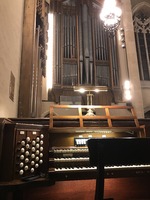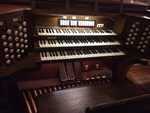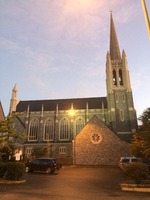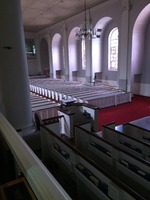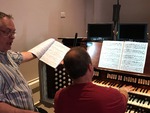I was asked to review Sunday and Monday, August 6 and 7, of the Organ Historical Society convention this year. I dutifully listened intently, took my notes, wrote my best, and submitted on time. No one's reviews were ever published, for whatever reason. So mine is now yours to read!
****************************
There is a simple formula for organizing an OHS convention: visit and hear as many organs as possible. The convention proper is a four-day affair, but there are abundant pre- and post-convention activities that also follow that winning formula. If one has the week to spare, then an OHS convention is an organ lover’s and organ historian’s paradise of instrument after instrument, recital after recital. There is no agonizing over what to choose to attend and what to skip. There are no what-ifs; everyone attends everything, even if in pre-determined shifts. So long as you make it onto the bus first thing in the morning, then you need not think about schedule nor your next meal for the rest of the day. It is a foolproof formula. Take that formula into the Twin Cities, one of America’s premier cultural and organ building areas, and the 62nd Convention 2017 was sure to please.
OHS is discriminating but not discriminatory. They like it all (so long as it’s played on a pipe organ). For the two days presently under review, we were treated to a sumptuous feast of compositions, acoustics, architecture, beautiful voicing, and solid playing, not to mention the usual delectable meal offerings.
SUNDAY: KEN COWAN
The convention proper began at the Cathedral of St. Paul with a recital played by perennial favorite Ken Cowan, on the E. M. Skinner and Aeolian-Skinner instruments. Opening comments were mercifully brief and beautifully germane to the proceedings. We heard gracious greetings from the Cathedral’s Rector, the Rev. John Ubel, and from Director of Music Lawrence Lawyer, plus opening comments from convention co-coordinator Michael Barone and from Christopher Marks, outgoing Chair of the OHS Board of Directors. Sam Baker, Chair of the E. Power Biggs Fellowship Committee, introduced the record-breaking twenty-three Biggs Fellows for this year. By far, this program that provides convention attendance scholarships to deserving students is one of the most exciting recruitment tools to the organ in our country and in our time.
If it were not obvious before this week, this convention confirmed that transcriptions are definitely back, at least among several high-profile performers (and their students). Cowan opened with George Baker’s re-arrangement of Horowitz’s rendition of Liszt’s transcription of the Rácóczi March from Berlioz’s Damnation of Faust. That is a mouthful, but the phrasing was perfect, and myriad colors abounded from both organs. Cowan “rode” the acoustics superbly, and his command of console technique is always worth the price of admission alone. The orchestral smoothness of the organs was demonstrated all night by Cowan’s careful and loving registrations. To this listener seated very near geographical center of the room under the dome, the notes were surprisingly clear, despite hearing negative comments all week regarding the “muddy” acoustics of the room. Such was just not evident to this writer.
Then followed the Whitlock Fantaisie-Choral in D-flat, a quiet, beautiful, lush color exercise that again showed Cowan’s absolute skill with using two organs in a huge acoustic. Cowan never got in the way; it was as if listening to Whitlock improvise it himself.
Our hymn was Down Ampney, sung to its usual text “Come down, O love divine.” Between the organs, the acoustic, and the sound of the singing gathered, it was a thrilling moment. One suspects that throughout any given convention, OHS brings to each set of church authorities an arresting vision of how congregational singing might have once been and might once again be. If only we (read: they) could get out of the way sometimes.
Composer Henry Martin’s project of writing Preludes and Fugues in all keys should become a stunning recording project some day. Cowan played the G Major, which he described as “particularly vivacious.” The fugue marked the first and only time the notes piled up in the acoustic, to this listener’s ears.
Lemare’s arrangement of “Wotan’s Farewell” from Wagner’s Die Walküre represents a transcriptional pinnacle of organ music. In the hands of a lesser artist, such a heavy piece after the Berlioz and before the Dupré to come would have become tedious and weighty for the program. In the other direction, Rachel Laurin’s Étude-Caprice: “Beelzebub’s Laugh” would have been one fast, fluttery, fluffy piece too many. But in both cases, Cowan’s artistry saved the day, using the organs to complete advantage and serving only the music each time. The Laurin has an interesting backstory, in that fellow Canadian Cowan commissioned it as a sort of “sequel” to the hugely popular Étude Héroïque. It contains a “buzzing bees” theme, as well as a “ha-ha-ha” theme introduced by the pedal.
This listener considers this program’s climax to be the Karg-Elert Fugue, Kanzone und Epilog, the third of three “Symphonic Canzonas,” for organ, violin, and treble quartet. It includes quotations from Karg Elert’s previous treatment of “Jesu, diene tiefen Wunden,” as well as the line Credo in vitam venturi from the Creed. To say the work is lush and ravishing would be an understatement. To say it was stunningly appropriate to this ecclesiastical and acoustical venue as well as to today’s societal unrest would be the least one could say. It was a transcendental experience of harmony, text, blend, edification, and sheer beauty. This piece, with its long, gentle, final chord plus added sixth, could very well have closed the program without further ado.
Cowan closed with a perfectly executed reading of the Dupré Variations on a Noël, followed by an encore, the Thalben-Ball Variations on a Theme of Paganini, for pedals alone. During an event such as this, which usually follows the trials and tribulations of a day’s travel, one’s mind can wander in many directions such as questioning the choice of that piece or those pieces or that style, how much practice time it must have taken to set all those pistons, the genius involved with setting those pistons, why we need encores, and myriad other elements of this rather stunning performance. Few such as Cowan could have pulled off a program such as this, and one is grateful that it was indeed someone such as him at the console.
MONDAY: JOHN SCHWANDT
Our first bus ride of the week carried us to the Mount Olive Lutheran Church in Minneapolis, a most venerable source of great American Lutheran musical tradition, made so by Paul Manz (1919-2009) and now carried on by David Cherwien. Surely the Manz history that hangs in the air was brought back to the fore when such a perceptive audience of musicians entered the doors, and it was made even more poignant to discover that Dr. and Mrs. Manz are interred just a few feet away in the side chapel. The convention spent a magnificent hour here this morning, celebrating the Manz legacy via the artistry of featured recitalist John Schwandt. Schwandt’s program was made up of many pieces Manz played on the inaugural program in 1966, including several of Manz’s famous improvisations he used in church as ‘chorale preludes’ in the literal sense. Schwandt briefly introduced us to the Schlicker organ that Manz designed, drolly assuring us that Manz never hesitated to “blaze a trail” of hymnic melody with the Trompeta Real as needed.
The program began with the audience singing Lobe den Herren, introduced by a rather thrilling and brilliantly executed Manz introduction. It is equally thrilling (and a bit endearing) that the convention does not necessarily face forward to sing; rather, we turn to face the organ, wherever it is! In this case, we stood and turned 180 degrees to face the Schlicker, surely a far more edifying experience than singing at screens as in so many churches.
The program continued with a curious hodgepodge of a Pieter Cornet Fantasy, a Loeillet Aria, and the Franck B Minor Choral, all assumed to be present on Manz’s inaugural program. It is interesting to look back at what people were playing in those days – “eclectic” was a frequent buzzword, but German was most often the medium in voicing and repertoire. Indeed, the presence of Loeillet and Franck on this particular organ in this particular church is a bit of a stretch. The organ – particularly its reeds – didn’t do Franck much justice, and Schwandt’s extensive rubato and exaggerated attention to mere figurations seemed to remove any real expression the organ had left for Franck.
From there, we sang one stanza of each of three hymns introduced by exquisite Manz improvisations: Wachet auf, Sellenbräutigam, and Wie schön leuchtet. Schwandt seemed unprepared for the first one but quickly regained his usual brilliant stage presence and brought the program to an exciting conclusion with the Monnikendam Toccata and the ever-popular Manz setting of Cwm Rhondda. Schwandt warned us that he was going to end the (Manz) improvisation with some of his own re-harmonization that Manz once heard and permitted. We all approved at the end. However, it can be an interesting experience to try to sing a hymn with a top-shelf improviser at the console. This was trickiest during Cwm Rhondda in terms of harmony, breath points, and tempo stability.
Church authorities all over tend not to enjoy hearing about how things used to be with music in their space, but this was the time and place to hark back to the past, and it was appropriate and most welcome for all. An unapologetic and exhilarating Manzfest, a fine start to a beautiful summer Monday morning in the Twin Cities.
MONDAY: DANIEL SCHWANDT
The Hinners organ in the Prospect Park United Methodist Church is a bit of a buried treasure. With a specification of only thirteen stops, it filled this room rather arrestingly with a nice foundation of primarily 8-foot tone. Daniel Schwandt began his program with a clear reading of the Mendelssohn fifth Sonata, a fine choice for this instrument. From there, he announced that he had time to insert the Franck Cantabile, which brings us to an interesting point for OHS conventions: stay on schedule, even if it means you can add something to your program! It was nice to be able to enjoy just one more piece, and as it turns out, it was a highlight of stylistic and musical integrity on this program. Schwandt had a good sense of when to repeat or tie individual notes in Franck’s otherwise vertical harmonies. He also went to the trouble to set up pistons on this two-manual organ to approximate Franck’s three. Finally, he cleverly achieved a continuing decrescendo at the end by replacing the Oboe with the Viol, which had just the right amount of “pierce” to simulate a distant reed. Kind of breathtaking, actually.
Excerpts from Dan Gawthrop’s Sketchbook 4 were again an excellent choice of repertoire for this organ. The Sinfonia could have used a bit more pulsing in the flowing chant rhythm, while the Mutanza was nice and clean in its changing meter. Violinist Cara Wilson then joined Schwandt for a reading of two of the Rheinberger Six Pieces, Op. 150. As it turns out, the acoustics are as kind to the violin as they are to the organ. This was a lovely collaboration in a marvelous space.
The program closed with the audience singing a text by local poet Susan Palo Cherwien to the beautiful tune Berglund by local composer Robert Buckley Farlee. The organ was used to excellent text-painting effect. The violin participated in the introduction and a brief ‘postlude’ to the hymn, plus a coloratura final stanza descant. Even against our voices raised in earnest song, the acoustics carried the violin right to our ears. Note to self for the future: it is probably going to be a one-sided experiment to pit men’s voices against women’s at an OHS convention.
MONDAY: GREG ZELEK
The Kilgen in Holy Cross Lutheran in Minneapolis does not impart the warmth its generous foundational spec might suggest, and the acoustic is not at all sympathetic. Furthermore, the swell box opens suddenly but closes gently, which means that throughout Greg Zelek’s recital, all crescendi were harshly subito, while all diminuendi were breathtaking.
Zelek opened his program with John Weaver’s Fantasia, a piece wholly suited to Zelek’s Juilliard pedigree. From there, the program slid a bit downhill. Nigel Potts’s transcription of the Liszt Liebesträum No. 3 might have worked on this organ, at least from a cursory look at the spec, but it didn’t work in the acoustic. Potts calls for many instances of parallel octave motion and other knotty requirements that in the absence of a damper pedal need an acoustic to remain luxurious. It did not impart enough romance in this ‘love dream.’ Zelek used the harp to fine effect in the cadenzas, but the harsh zimbelstern at the end just didn’t work.
Zelek continued with his own transcriptions of Ernesto Lecuona’s Danza Lucumi and famous Malagueña, prefaced by some verbal notes to connect to Zelek’s own Cuban-American heritage. The transcriptions were beautifully and lovingly realized, and the organ’s tutti was raucous enough with its super couplers to communicate the idea of a fiesta, but the chest action of the organ was just no match for the sharp rhythms required. A truly unfortunate choice of repertoire for this instrument.
We closed by singing “For the beauty of the earth” to its usual tune Dix. Zelek demonstrated a nice sense of rhythmic motion and filling in longer notes, hymn-playing skills often lacking. A greater metrical sense of 2, rather than 4, might have overcome the acoustical dullness.
MONDAY: JOHN FERGUSON
With John Ferguson’s recital on the landmark Casavant in the equally landmark Central Lutheran Church in Minneapolis, we enjoyed our second festival of the day honoring venerable Lutheran musicians. Ferguson appeared in his usual energetic and impish glow and made some helpful opening remarks about division placement throughout the chambers and the resulting havoc that has been wrought on tuning since the organ’s installation. One happily reports that the organ sounded good on this day. The convention also dodged a bullet, in that most of the entire campus of the church, save the sanctuary, was just about to be torn down and rebuilt. The fences were up, and the cranes were present!
Ferguson played a program that in only 45 minutes took us through the Liturgical Year, including two hymns and an enormous postlude. His familiarity with this organ (he was Cantor on it for a few years) was evident and allowed everyone to enjoy hearing what this organ could do. The opening hymn tune Wojtkeiwiecz was ravishing, with Ferguson being generous with registrational text painting and stirring rhythm for the text “Rise, shine, you people.” From there, Ferguson quickly nodded to the seasons of the Church Year with straightforward readings of Bach Wir glauben, Buxtehude Nun komm, Purvis “What child is this,” Manz “O Morning Star,” Langlais “O Sacred Head,” Lovinfosse “The Strife is O’er,” and Duruflé chorale on Veni, Creator. The Purvis in particular was a nice color demonstration. The zimbelstern used during the Manz should be the model for all builders. The Lovinfosse, in its mere four-minute length, was quite the aural representation of battle between good & evil.
We continued by singing a moving rendition of “Shall we gather at the river.” With a deep registration and occasional “pulsing” of chords, one could feel the depths swirling under one’s feet. The Reger Toccata and Fugue in D was the “postlude” for this recital, and it did not fail to deliver Reger’s usual chromaticism and dynamic contrast, a rather enormous tutti, and Ferguson’s superb, sweeping management of it all.
MONDAY: NATHAN LAUBE
After on-your-own dinner in the Nicollet Mall area of Minneapolis, we gathered in the Basilica of St. Mary for Nathan Laube’s recital on the rather imposing Wicks organ. Laube opened with a dramatic and thrilling performance of the first movement of the Widor Sixth, choosing an appropriately slower tempo than one normally hears, which only heightened the grandeur of the piece, the space, and the occasion. One wonders why Widor marked some movements as fast as he did, given the acoustic in which he himself worked. Laube addressed the audience, offering a brief and elegantly refined discourse on the “cathedral” nature of the evening’s program, whether written by cathedral musicians or written for huge, cavernous, cathedral-like spaces, or in the case of the final piece, a ‘temple.’
Laube continued with the dreamy “Mystique” from Widor’s Trois Nouvelles Pièces, a late, non-symphony opus. From there, it was on to two Demessieux chorales on Gregorian chant themes, which were wandering in their writing, beautiful in their effect, and “earnest” (Laube’s word) in their intent. The theme of transcendent beauty continued with the audience singing General Seminary. The organ supported well, the organist gave and take most beautifully and appropriately, and we were transported even more by the arresting sound of descanting rendered by several professional voices in the rear gallery. Those voices were about to figure more prominently into the program.
Laube then played George Baker’s Deux Évocations – one dedicated to the memory of Vierne, the other to Cochereau. True to Baker’s complete assimilation of the French style in which he studied, these pieces were chant-based, Impressionistic (if one will), and generous in their use of the full dynamic spectrum of the organ. The use of chant was subtle rather than transparent; this listener heard strains of quite a number of favorite chant bases including Victimae paschali laudes, O filii et filiae, and Haec dies (perhaps a nod to the Widor Symphonie romane?).
From there, it was on to a little-heard opus by Notre Dame Cathedral organist Olivier Latry, based on a set of his improvisations. This was a series of seven lines of Latin text and their attending Gregorian melodies, each one sung in turn by the professional voices “planted” in the rear gallery and then followed by Latry’s published improvisation on each. The texts covered the gamut of a worshipper’s expressions such as Salve Regina, Ad te suspiramus, Ad te clamamus, and O Clemens: O pia. As expected from most French improvisations deemed worthy of publication, the text painting was palpable and the textures constantly changing. Latry’s trademark pregnant pauses, rumbling pedal support, and thick harmonies easily put one in mind of listening to Latry himself play. Add in the substantial earnestness in Laube’s presentation, and the effect was truly sublime. Although the harmonies were surely not to everyone’s taste, if one only imagined themselves peering over the gallery rail into a darkened Notre Dame Cathedral while Latry improvised the original, then one could not help but be both humbled and moved to a more profound ‘Alleluia.’ The ending was huge, nearly triumphant, but with a chromatic tinge to keep our humanity in check. It all faded away to strings holding unison Cs, like a guiding star. As at Ken Cowan’s recital the previous evening, a piece like this might have ended the program and left everyone to ponder their lot in a somewhat subdued fashion on their way back to the bus. But Laube was not finished, not by a long shot.
Based on what we had just heard, the presence on this program of the Overture to Tannhäuser seemed out of place. But a quick reminder that Wagner considered the opera house a “temple” (or for us this night, a cathedral!) quickly placed this piece in perspective as a stroke of programming genius. Laube had prepared a program that was as much a journey (assuming we were willing to take it) as it was a celebration of the convention’s purposes. This particular piece works so well for the organ that perhaps Wagner should have been an organist. And Laube did not disappoint, with his customary musical elegance at every turn, subtle and noble re-working of the original transcriptions by Samuel Warren and Edwin Lemare, and a careful control of excitement to the very end. The organ built itself up admirably all the way to the final brass pronouncement of triumph and absolution. Surely that huge, final E-Major chord and Wagner’s now familiar tune were being whistled, hummed, and ear wormed on every bus all the way back to the hotel in St. Paul.
 Saturday, October 7, 2017 at 12:02AM
Saturday, October 7, 2017 at 12:02AM  Joby Bell | tagged
Joby Bell | tagged  Widor recordings
Widor recordings 
